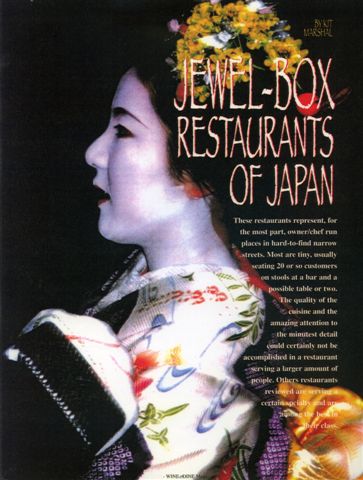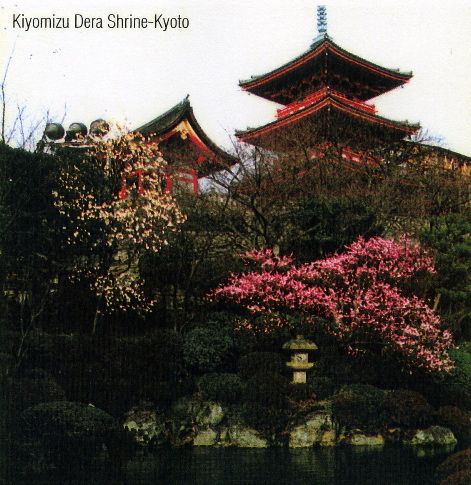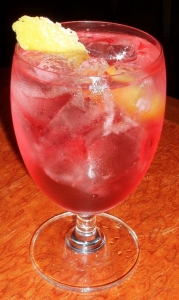Pictured above is the Cover Page of an article I wrote for Wine & Dine Magazine featuring this photo of a Miko Girl in Kyoto. The shot was very difficult to obtain as these young girls, in training to be Geisha Girls, do not like to be photographed, though my Japanese wife was insistent on capturing this photo and had to chase her down the street to take it.
These restaurants represent, for the most part, owner/chef run places in hard-to-find narrow streets. Most are tiny, usually seating 20 or so customers on stools at a counter-bar and a possible table or two.
The quality of the cuisine and the amazing attention to the minutest detail could certainly not be accomplished in a restaurant serving a greater amount of people. Other restaurants included are serving certain specialties and are among the best of their class. About a third of the establishments originally included have gone out of business and have been eliminated from this update. Note: The magazine’s editor had space constrictions and severely edited the text.
Steak House Hama
7-2-10 Roppongi, Minata-ku, Tokyo
Tel. (03) 3403-1717
Opening Hours: Lunch Noon-2:30pm
Credit Cards: All Major
Prices: Very Expensive
(other branches around the city)
A handsome interior with highly lacquered chairs that are more suitable to a company board room. These steak restaurants serve high-quality produce at extremely expensive prices; they mainly cater to show biz personalities and business moguls on expense accounts.
Stainless steel flattop grills trimmed in brass and fine woods are a far cry from Benihana of Tokyo, the laughable chain of comical grill men that try to entertain the masses in the U.S. One steak is a minimum of $100, foie gras $40.00, rice with garlic a mere $12, a simple Macon Village White Burgundy $70.00 and corkage charge $50.00 a bottle. (expect that these prices may have doubled as these prices were valid a few years ago).
Le Recamier
2-3, Moto Azabu 3-chome, Minato-ku, Tokyo, 106-0046
Tel. (03) 3408-5044
Opening Hours: Lunch:11:30am-2pm; Dinner: 5:30pm-10pm
Credit Cards: All Major
Prices: Moderate-Expensive
This restaurant is named after the time-honored hangout for journalists in Paris, on the quiet rue Recamier. A former chef now cooks seasonal specialties in Tokyo. The cuisine is top rate and the prices are well below other spots of the same caliber.
Queen Alice
3-2-3, Mooto-Azabu, Minato-Ku, Tokyo 106
Tel. (03) 3402 9039
Opening Hours: Lunch:11:30am-2pm; Dinner: 5:30pm-10pm
Credit Cards: All Major
Prices: Moderate-Expensive
This Picturesque restaurant has several nicely appointed rooms, all are crammed with tables and chairs to the absolute maximum, to shift your chair even a few centimeters from the table you might restrict the movement of the waiters. A solarium tucked away at the back of the restaurant is pleasant enough, especially at lunch on a gloomy day. The praiseworthy French cuisine is complimented by a well-stocked wine cellar.
Cafe La Boheme
Minami-Aoyama
1 Fl. Kaneko Bldg. 7-11-4 Minami-Aoyama, Minato-Ku
Tel. (03) 3499-3377
Opening Hours: 11:30am-5am
Credit Cards: All Major
Prices: Moderate
Cafe La Boheme is one of eight moderately priced little bistros located around Tokyo. the cooking is quite good considering the prices that are dirt-cheap by Tokyo standards. Two can dine here with a carafe of white and a carafe of red wine for $50. Salads, pasta and the special Japanese pastas are good. The restaurant in Aoyama is very nice-looking and draws and interesting crowd until 5am in the morning. I commend this restaurant chain for their efforts and I wish that every city in the world should aspire to have comparable restaurants open most of the day and night, serving good food and wine at reasonable prices.
Yoshihashi
Tel. (03) 31129 4129
Minato-Ku Moto Akasaka 1-5-25
Opening Hours: Lunch:11:30am-2pm; Dinner: 5:30pm-10pm
Credit Cards: MC, Visa
Prices: Very Expensive
Sukiyaki
A small, charming place serving Sukiyaki. Everything is cooked separately in front of you. An egg wash is made by painstakingly beating the whites with chopsticks while avoiding breaking the yolk that rests in the center. The resulting bowl is fluffy whites around a yellow yolk moon in the center where you dip the Sukiyaki. A difficult task, I can tell you, as I tried to do it and made a mess. There is a comfortable little bar if you wander down the little path that leads to the back of the restaurant.
Daini’s Table
6-3-14 Minami-Aoyama, Minata-Ku
Tel. (03) 3407-0363
Opening Hours: Lunch: 11:30am-2pm; Dinner: 5:30pm-10pm
Credit Cards: All Major
Prices: Expensive
This small space is decorated in tones of lacquered dark green and striking Chinese red. The bar is red and the tables green. Exquisite antique kimonos are inset into recessed spaces in the walls and are protected by glass. The kitchen of this small restaurant puts out quality Chinese cuisine in French-style courses rather than all at one time as is customarily Chinese.




